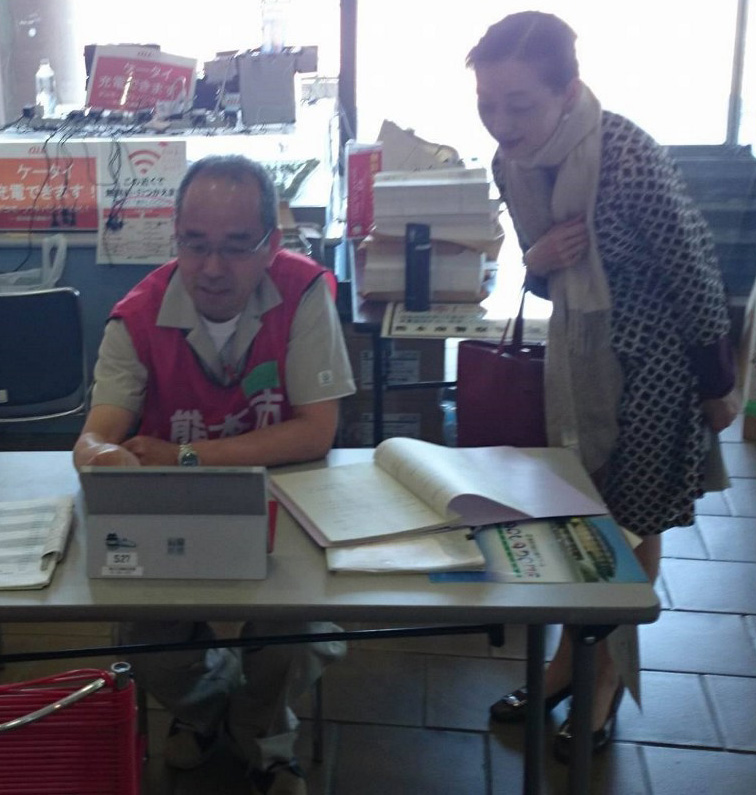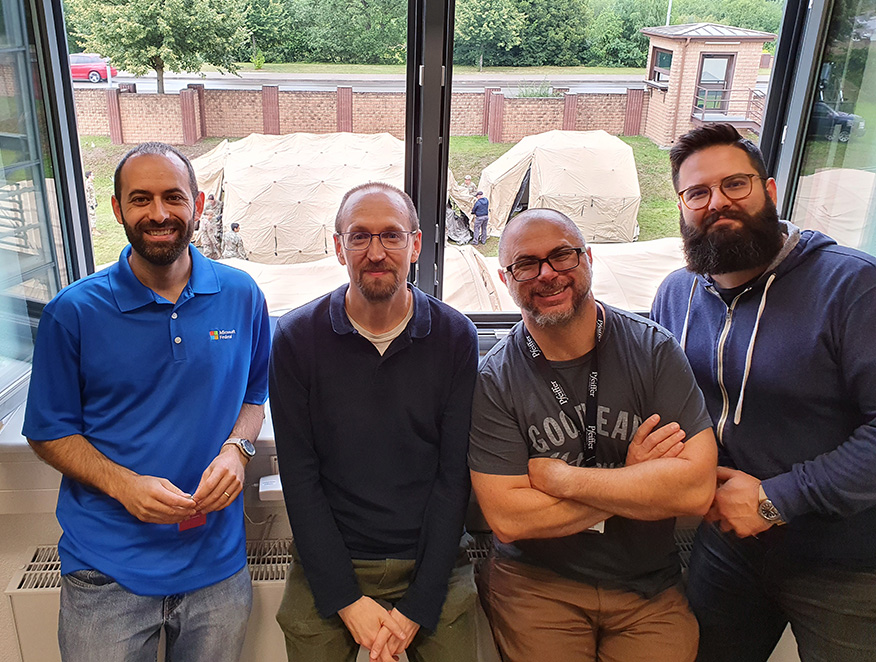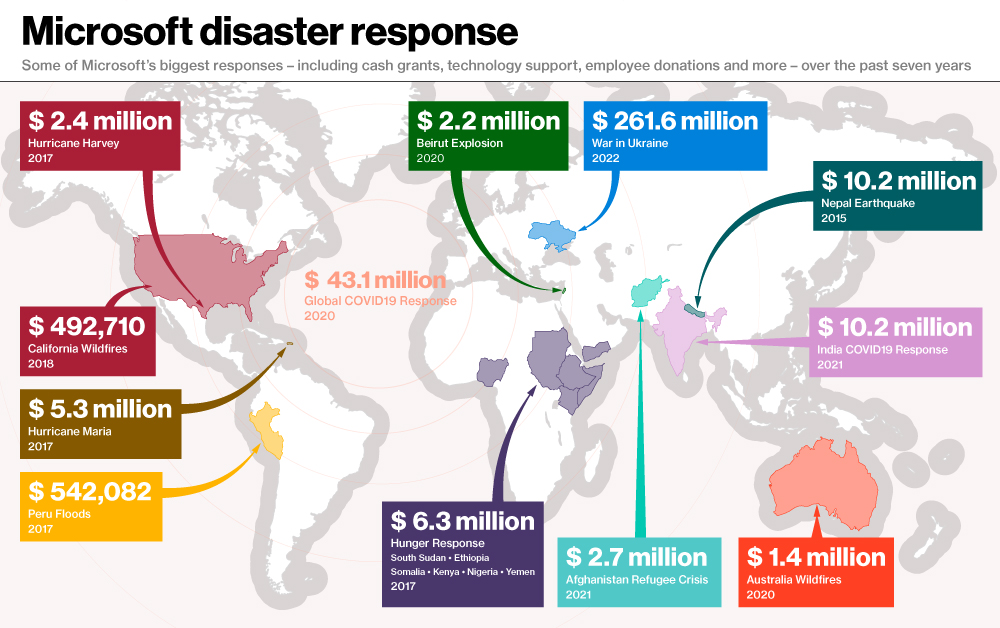“When you get off the train, you might have enough savings to get to a group home and support yourself for a little while, but that usually dries up quickly, and it’s important that help be available as soon as that happens,” says Helena Krajewska, a Polish Humanitarian Action spokesperson who met the Dubohray family in June. “People were applying to us for help without much hope, because they hadn’t received assistance from others, and they were surprised to receive support so quickly from us.
“Technology played a big role in this,” Krajewska says, “because it sped up the process and allowed us to process a lot of applications at the same time.”
The impact of technology during times of crisis has always been clear and has become even more critical in recent years. Global warming has brought more catastrophic storms and floods affecting hundreds of millions around the world. In just the past few weeks, Microsoft has activated giving campaigns to help those affected by Hurricane Fiona in Puerto Rico and Hurricane Ian in Florida. Disaster response teams are providing technical assistance and resources to organizations in need.
The coronavirus pandemic brought unprecedented global challenges as well, and Microsoft’s disaster response efforts have grown accordingly. The company has honed its processes to make a timely difference in the communities where it operates, not just through software and hardware donations but by harnessing the skills of a vast global workforce made up of people longing to help with their time, talents or money.
“Unfortunately, we’ve had too many opportunities, over the last few years particularly, to build our muscles for disaster response,” says Kate Behncken, who’s been leading Microsoft Philanthropies since 2019 and saw employee giving skyrocket for the COVID-19 and Ukraine response efforts. “The level of energy across the company for the social impact work Microsoft does is at an all-time high. Employees will often say it’s one of the things they value about working at the company, the fact it values both profit and purpose and invests in both.”
The seriousness with which the company takes its role in society — executives often say giving is “in our DNA” due to the influence of Microsoft founder Bill Gates’ philanthropic mother, Mary Gates — is what drew Lena Ryuji there 15 years ago. She now leads philanthropic engagement in Japan, a country that has had to cope with more natural disasters than most, so she keeps the disaster-response team on speed-dial.
Ryuji was working with nonprofits to help the most vulnerable in the aftermath of the 2011 earthquake and tsunami when a Japanese state government official reached out. It was taking days to issue critical reports to the public on the radiation levels after the Fukushima nuclear accident, as inspectors used paper and fax machines to report from dozens of monitoring posts around the country. Within a few hours, Ryuji and her colleagues pulled together a team and had Microsoft engineers working on the problem. When she woke up the next morning, the system was in place with a secure and mobile cloud solution.

That experience wasn’t an anomaly, Ryuji says, adding that employees have jumped in to help with mudslides, floods and other emergencies that have taken place every year. And just as Microsoft is helping governments and first-responder organizations prepare ahead of time for disaster relief, it has refined its own methods to be more effective. Each department has assigned individuals who understand how the company and its employees are equipped to help, how to reach the right contacts and how best to work together so it’s not a scramble in the midst of a crisis, Ryuji says.
“I really appreciate that we as Microsoft are also prepared, that we have a process that’s handled centrally and that we are trained on,” she says.
Erich Pfeiffer was working for Microsoft as a principal consultant at the U.S. military’s Ramstein Air Base in Germany last year when the Taliban’s seizure of Afghanistan led to the largest air lift in U.S. history. He watched as a runway was turned into an impromptu tent city to house a steady stream of unexpected refugees.
“I went home late that Friday night and thought, ‘We have a disaster response unit in Microsoft, so I wonder if we can do anything to help,’” Pfeiffer recalls.
By the end of that weekend, he’d gotten a mission approved to help with the Afghanistan evacuation. Work began Monday morning to create a digital system to track and manage housing, food and ration cards, and more for the thousands of refugees suddenly living on the base.
“There were people who had been on planes for 15, 18 hours, just come out of a war zone, and while they’re waiting to be processed they don’t have a bed to sleep in and they’re just sitting on the ground for hours,” Pfeiffer says. “So the faster you can get them processed, the faster you can get them settled down to recuperate.”
Engineers, cybersecurity experts and a whole infrastructure team from northern Germany all rushed in to help, giving up sleep themselves for days, Pfeiffer says. They built an application and set up dozens of consoles that helped track, locate and reunite families amid the mayhem and more than quadrupled the number of refugees getting processed each hour to about 250, only stopping because that was as fast as tents could be set up.

“We were empowering the people processing them to get these folks moved through to a better place where they could have a better life,” Pfeiffer says. “There isn’t a single one of us who wouldn’t do it all over again. And in fact, we all are. Fast forward to February and every one of us is back at it helping displaced people again, but from Ukraine this time.”
Pfeiffer and his colleagues have harnessed their experience to create volunteer and refugee management systems around Europe, helping Ukrainians find housing, join their host countries’ healthcare systems and more. Depending on the situation, they volunteer their hours or bill Microsoft’s disaster response team as a member of a formal company engagement, Pfeiffer says.
“Everything Microsoft’s disaster response team does — everything — is at zero cost and has to meet one simple criteria: It has to relieve human suffering,” he says.
Beyond the free disaster-response assistance, Microsoft gave $2.5 billion in grants and discounts to more than 300,000 nonprofits last year alone. And the new Microsoft Cloud for Nonprofit provides solutions for activities every charitable organization around the world has to manage — fundraising, program design, volunteer management and the like — so such groups can respond faster and more efficiently, especially during times of crises.
Microsoft also matches employees’ volunteer time and cash donations through the Employee Giving program, which is almost as old as the company itself and has provided $2.49 billion in assistance over the decades.

It uses its wide reach to partner with customers as well. Xbox, for example, teamed up with the gaming community to raise millions of dollars for organizations including World Central Kitchen, which has been feeding people all over Ukraine since the day after the first missile hit on Feb. 24. LinkedIn gives grants to nonprofits that help newly settled refugees find jobs that match their skills, and it created a site with tools for displaced people that’s available in seven languages. Microsoft Advertising offers ad grants on channels including Yahoo and MSN. And Bing provides awareness on the home page and directs users to fundraisers and other ways to help.
While the war in Ukraine has dominated news in 2022, there are more displaced people in the world than ever before, with 100 million refugees fleeing wars and natural disasters. Tech companies are uniquely placed to help, especially since technology now touches every aspect of life, says Juan Lavista Ferres, Microsoft’s chief data scientist and the director of the AI for Good Research Lab.
“There are problems that only artificial intelligence can solve, and more than 90% of AI experts work in the tech and financial sectors, not the nonprofits or governments,” Lavista Ferres says. “So we as a company have a responsibility to use our knowledge to help the world.”

Be the first to comment